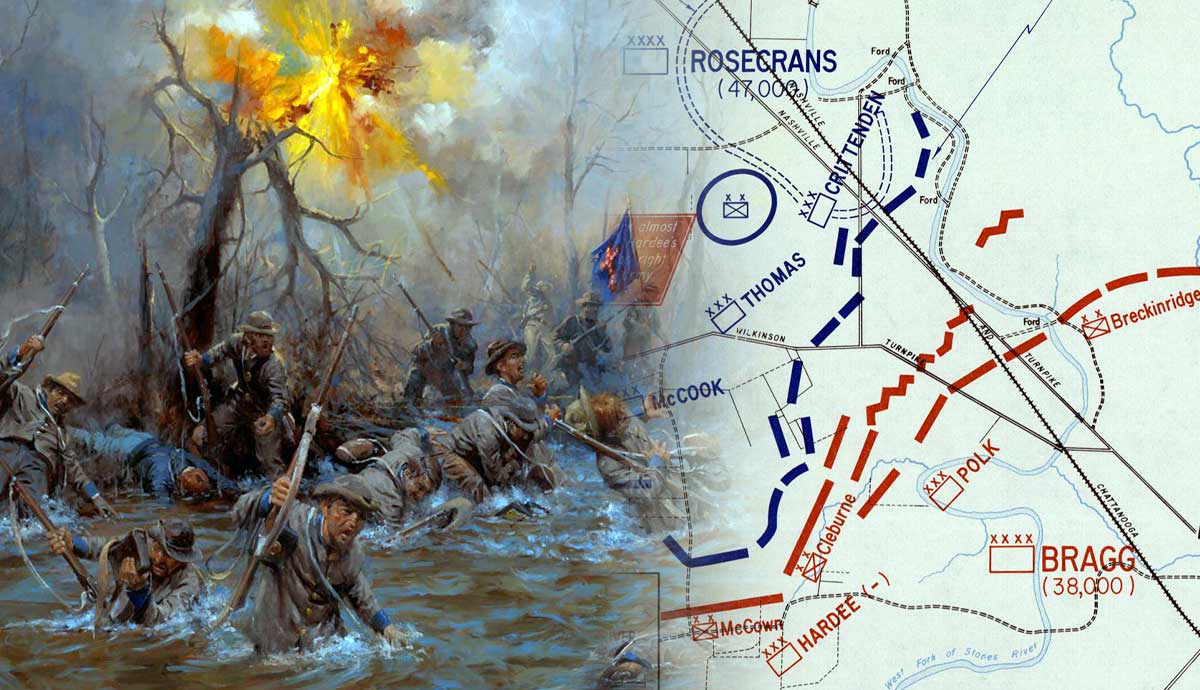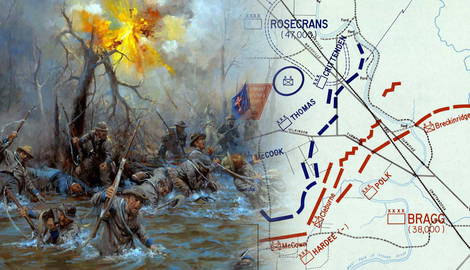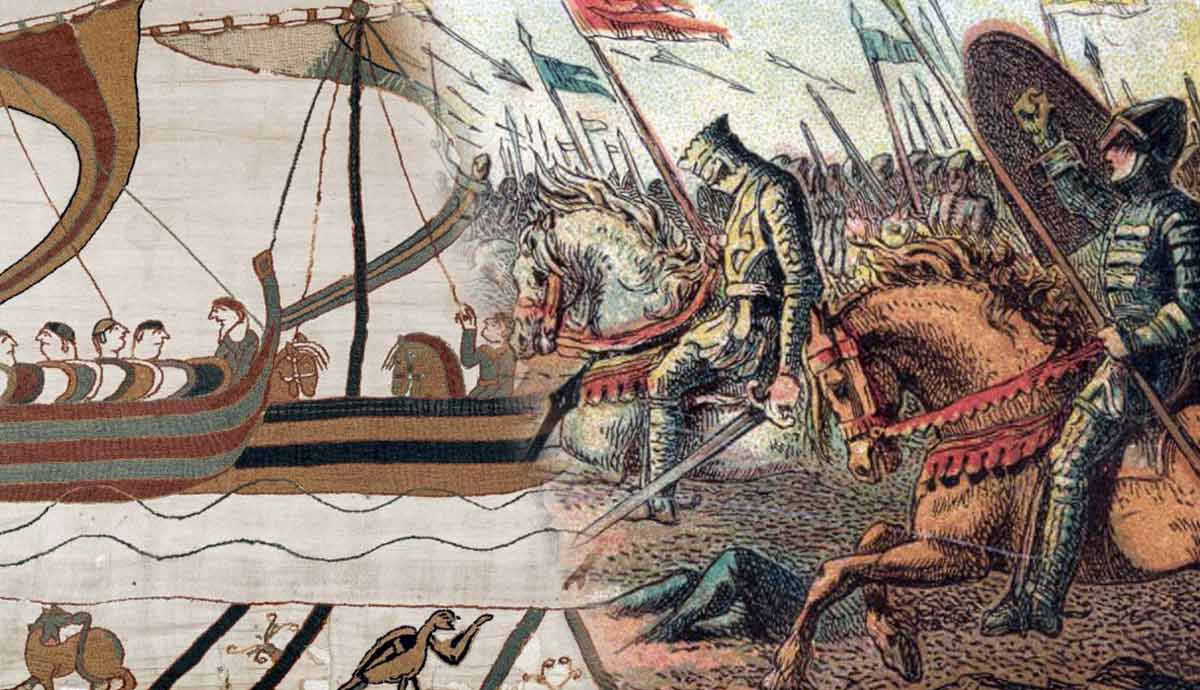
Tennessee, just south of contested Kentucky, was one of the earliest Confederate targets of the Union. After the Union managed to hold onto the border state of Kentucky, it immediately went after Tennessee, but faced stiff resistance. The Battle of Stones River was an inevitable post-Kentucky showdown between two generals who took their time preparing amid political bickering that neither was up to the task.
Victory Goes to the Union

The Battle of Stones River was a brutal slugfest. After eyeing each other in central Tennessee, the armies of Union general William Rosecrans and Confederate general Braxton Bragg planned to attack each other, hoping to win the region for their respective countries. Despite the initial success of a Confederate attack on December 31, 1862, the Union eventually held firm as the Confederate follow-up was uncoordinated. After prematurely declaring victory that evening, the Confederates failed to notice the maneuvering of Union reinforcements.
A second Confederate attack on January 2 failed, thanks to the Union reinforcements, who counterattacked. Bragg realized that Rosecrans had more men and would receive additional reinforcements, which led to his decision to withdraw on January 3. Although little changed for the South, the North saw the narrow victory as very substantial due to US President Abraham Lincoln’s Emancipation Proclamation, given after the Battle of Antietam in September 1862. The Proclamation, which took effect on January 1, 1863, would be seen as meaningful only if it came alongside Union military victories.
Timeline of the Battle of Stones River

The Union loss at the Battle of Fredericksburg in December 1862 was a morale-crusher for the Union. President Lincoln wanted to both rectify this loss and win a Union victory that would accompany the carrying out of his Emancipation Proclamation on January 1, 1863. In central Tennessee, the army of Confederate general Braxton Bragg was only 30 miles from that of Union general William Rosecrans, setting up an opportune conflict.
Ordered to engage, Rosecrans began moving his army south on December 26, 1862 to find Bragg’s forces.
Late in the day on December 30, the two armies faced each other near Murfreesboro, Tennessee.
Early the next morning, the Confederates struck first and drove back the Union units, with massive casualties on both sides due to fierce, nonstop combat. Rosecrans called up reinforcements, who saved the day from a Union defeat with the help of skillful artillery. Confederate artillery struggled to join the front line through thick forests, giving the Union a firepower advantage.
After a day of rest on January 1, Bragg ordered another attack on the afternoon of January 2. The Confederates ran into massed Union cannons that had a decimating effect on their ranks.
After a Union counterattack pushed the cannon-stricken Confederates back, Bragg withdrew on January 3, 1863.
What Caused the Battle of Stones River?

After having saved the border state of Kentucky from joining with the Confederacy, it was time for the Union to take the war into the South. Tennessee was the “top” of the South, and the Union began pushing through it from west to east. Although the Union had been gaining ground in its offensives in this Western Theater, especially with its victory in the Battle of Shiloh, the Confederate victory at Fredericksburg in early December of 1862 seemed to have stalled its momentum. Abraham Lincoln’s Emancipation Proclamation of September 1862 had declared that all enslaved people in states still in rebellion as of January 1, 1863 would be free. He wanted this date to fall on or after a Union victory, not its defeat at Fredericksburg.
The Battle of Stones River was anticipated by both sides in advance, as Rosecrans’ Army of the Cumberland was in close proximity to Bragg’s Army of Tennessee and the region of central Tennessee was clearly the next to be contested. Rosecrans also had some 80,000 men under his command, easily double that of Bragg. This allowed Rosecrans to leave half of them in Nashville, which the Union had seized early in the year, to protect it from Confederate attack. With his manpower advantage and President Lincoln needing a victory, Rosecrans was up to the task.
Why Was the Battle of Stones River Significant?

The Battle of Stones River was significant for multiple reasons, the first of which was its design to give the Union a victory that coincided with the Emancipation Proclamation taking effect. When Bragg withdrew on January 3, President Lincoln had his victory and an omen that the Union would prevail in the conflict. Secondly, the battle was infamous for having the highest percentage of casualties in a major skirmish during the war, with almost 4 percent of committed troops killed in action. Four of the dead were brigadier generals, an unusually high number of top-ranked officers.
After the defeat at Fredericksburg, the Union victory at Stones River was instrumental in maintaining morale and the will needed to continue the war without negotiating for an armistice with the South. Politically, the Lincoln administration was under pressure to show results toward winning the war. Although eventual victory over the Confederacy was virtually guaranteed, many in the North preferred to negotiate an armistice, potentially allowing the Confederacy to remain an independent state, to reduce casualties. Stones River bought Lincoln more time.
5 Facts About the Battle of Stones River

1. Casualties
Casualties during the two days of fighting totaled almost 25,000, with slightly more Union than Confederate (though keeping in rough relation to the proportion of troops each side fielded). With just over 75,000 men engaged in the battle, the high number of casualties meant that almost twenty percent, or one out of every five, was at least wounded in combat. Therefore, while Stones River was not one of the largest battles of the war, it does go down as one of the most intense.
2. Commanders
Union forces were led by General William Rosecrans, a West Point graduate with relatively little combat experience. Unlike most of his fellow Military Academy alumni, he did not serve in Mexico during the Mexican-American War. An engineer, he worked on several Army projects before resigning from the service in 1854. After the Civil War began with the Battle of Fort Sumter, Rosecrans rejoined the US Army as a staff officer under General George McClellan. He was eventually relieved of his command after his defeat at Chickamauga in September 1863, later retiring to California.
Confederate forces were led by general Braxton Bragg, who had served in both the Seminole Wars in Florida and in the Mexican-American War. Combative by nature, Bragg was almost drummed out of the US Army prior to the Mexican-American War, where his bravery and skill redeemed his reputation. Bragg’s temper toward subordinate officers meant he did not win their loyalty, which led them to call for his resignation after the loss at Stones River. Although Confederate President Jefferson Davis stood by Bragg at the time, he later replaced Bragg after the general’s defeat at Chattanooga.
3. Number of Forces Involved

Under Rosecrans, just over 41,000 Union soldiers were committed to the battle, which constituted about half of the general’s total force in Tennessee. Bragg had some 35,000 men, bringing the total of combatants to about 76,000. Therefore, Stones River was indeed a major battle, but was dwarfed by larger engagements like Antietam and Gettysburg.
4. Visiting Murfreesboro, Tennessee Today
Today, visitors can enjoy the Stones River National Battlefield near Murfreesboro, Tennessee. The battlefield has a large visitor center typically open from 9:00 AM to 5:00 PM and includes a bookstore. It can accommodate large groups of visitors, such as history class field trips from nearby schools, and is also open for driving tours. For those staying in the town of Murfreesboro, there are plenty of Civil War historic sites to visit in addition to the battlefield.
5. Trivia: Highest Casualty Rate in a Major Civil War Battle
Although not often remembered as a major Civil War battle, the Battle of Stones River is remembered as the most intense single battle, with a death rate of combatants almost reaching four percent. Other noteworthy casualty statistics go to larger battles like Antietam, which had the highest total casualties in a single day, or Gettysburg, which had the highest total casualties over a multi-day engagement. In terms of total casualties, the two-day Battle of Stones River ranks seventh overall, just behind the Battle of Shiloh and just ahead of Antietam.
Aftermath of Stones River: Union Aims at Chattanooga

After the successful Battle of Stones River, General Rosecrans aimed to protect the captured region of central Tennessee from a possible Confederate return. As a result, he turned much of Chattanooga into a fortress, and did the same with Murfreesboro. Toward this end, Rosecrans was successful: Tennessee became the only Confederate state to be fully occupied by the Union before the end of the Civil War in the late spring of 1865.
The Union victory on January 3 helped underscore the seriousness of Lincoln’s Emancipation Proclamation. By showing that the Union was not giving up the fight against a devoted Confederate resistance, the victory at Stones River helped reinforce the belief among foreign powers like France and Britain that the Confederacy was a lost cause and should receive no recognition or aid. It also likely encouraged more enslaved people in the South to risk seeking freedom by escaping to Union lines, where they could find shelter and employment in Washington DC.










